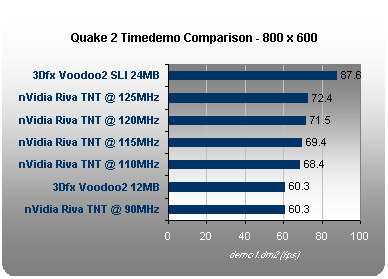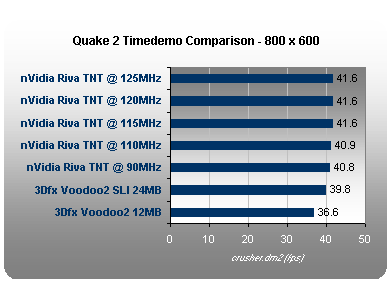The Cool Solution
Sitting at home, playing around with our newly developed cooling method, it was time to put it to the test. If you recall, nVidia claimed that their TNT would be a Voodoo2 SLI killer if it operated at its full potential, that being 125MHz. The problem at hand was overclocking a 0.35 micron processor running at 90MHz to 125MHz. In terms of system processors, this could be compared to overclocking an original Pentium II 233 to around 333MHz, and if you've ever had any experience with the first 233's that hit the streets, that wasn't too realistic of an overclock from a reliability perspective.
By constructing a cooling system designed to meet the needs of the task set before us, we managed to put together a crude system that would accomplish the cooling necessary to get the TNT to produce benchmarks at 125MHz, our goal. While the specifics of the cooling system cannot be disclosed as of now, we are currently working to see if it is feasible for mass production and you will see up to date information on the topic once the word is in. If it can be manufactured for use in normal home systems, you can expect it to retail for under $30.
Using a direct method of modifying the clock settings of the Riva TNT chipset, AnandTech ran tests at the standard 90MHz as well as the following overclocked settings: 110MHz, 115MHz, 120MHz, 125MHz, and 135MHz. Remembering that 125MHz is the sweet spot for the TNT, we should expect it to become a Voodoo2 SLI killer at that speed if nVidia's claims were well founded.
The Test
The Slot-1 Pentium II Test System AnandTech used was configured as follows:
An Intel Celeron 300A, and an Intel Pentium II 400 on an ABIT BX6 Motherboard
64MB Mushkin SEC PC100 SDRAM
Western Digital 5.1GB Ultra ATA Hard Drive
AOpen 32X IDE CD-ROM Drive
Windows 98 with all of the latest patches/drivers installed
The benchmark suite consisted of the following full version game titles
Forsaken - Running the Nuke Demo
Quake 2 v3.17 using Demo1.dm2 and Brett "3 Fingers" Jacobs Crusher.dm2 demo
TNT vs Voodoo2 - OpenGL - Quake 2 |
||||
Celeron 450A |
Timedemo - 800 x 600 | |||
| - | demo1.dm2 | % Change | crusher.dm2 | % Change |
| nVidia Riva TNT @ 90MHz (Default) | 60.3 | 0% | 40.8 | 0% |
| nVidia Riva TNT @ 110MHz (Overclocked) | 68.4 | +13% | 40.9 | +0.2% |
| nVidia Riva TNT @ 115MHz (Overclocked) | 69.4 | +15% | 41.6 | +2% |
| nVidia Riva TNT @ 120MHz (Overclocked) | 71.5 | +19% | 41.6 | +2% |
| nVidia Riva TNT @ 125MHz (Overclocked) | 72.4 | +20% | 41.6 | +2% |
| nVidia Riva TNT @ 135MHz (Overclocked) | Failed | - | Failed | - |
| 3Dfx Voodoo2 12MB @ 90MHz (Default) | 60.3 | - | 36.6 | - |
| Dual 3Dfx Voodoo2 12MB SLI @ 90MHz (Default) | 87.6 | - | 39.8 | - |

Using the demo1.dm2 scores as the realistic high end of the performance spectrum, and the crusher.dm2 scores as the lowest realistic performance scenario AnandTech ran tests at clock speeds ranging from 90 - 125MHz on the specially cooled TNT board. The results were amazing, at 125MHz, the performance increase under Quake 2 was a full 20% on the high end! While this doesn't bring a single TNT up to par with a Dual Voodoo2 SLI setup per the original claims of its performance, it does give you a considerable advantage over a single Voodoo2 at a much more reasonable cost. You decide whether or not this is worth waiting 5 - 6 months for. On an unrelated note, Canopus is promising new drivers on the 28th of September that will increase performance by around 20%, if Canopus claims are as great as they say they are, then you can except an update to this comparison in the near future with some benchmarks possibly closer to those of a Dual Voodoo2 SLI setup on a single TNT board.

The crusher.dm2 scores show very little improvement with the increased clock speed, the TNT still holds the advantage over even a Dual Voodoo2 setup due to its excellent AGP 2X implementation which allows for much data to be transferred over the bus in the most taxing of situations such as the one illustrated by the crusher benchmark.
TNT vs Voodoo2 - Direct3D - Forsaken |
||
Pentium II 400 |
800 x 600 | |
| - | Nuke Demo | % Change |
| nVidia Riva TNT @ 90MHz (Default) | 130.88 | 0% |
| nVidia Riva TNT @ 110MHz (Overclocked) | 138.93 | +6% |
| nVidia Riva TNT @ 115MHz (Overclocked) | Failed | - |
| nVidia Riva TNT @ 120MHz (Overclocked) | Failed | - |
| nVidia Riva TNT @ 125MHz (Overclocked) | Failed | - |
| nVidia Riva TNT @ 135MHz (Overclocked) | Failed | - |
| 3Dfx Voodoo2 12MB @ 90MHz (Default) | 96.26 | - |
| Dual 3Dfx Voodoo2 12MB SLI @ 90MHz (Default) | 177.13 | - |
The Direct3D tests would only complete on the TNT clocked at 110MHz, Forsaken would consistently crash at any higher clock speeds. Judging by the scores AnandTech obtained from running Quake 2 at 125MHz and comparing to the increase achieved by using a Direct3D benchmark, you can expect a 125MHz TNT to bring in Forsaken scores in the 140 - 150 fps range, still under that of a Dual Voodoo2 setup, but definitely above that of a single Voodoo2 card and definitely worth the money. Do remember that this performance isn't available now, and unless the cooler we constructed can be manufactured at a reasonable cost, you will have to wait another 5 - 6 months before you can get this performance increase.










0 Comments
View All Comments